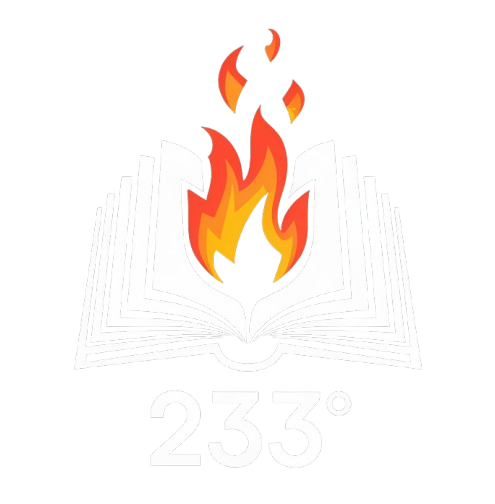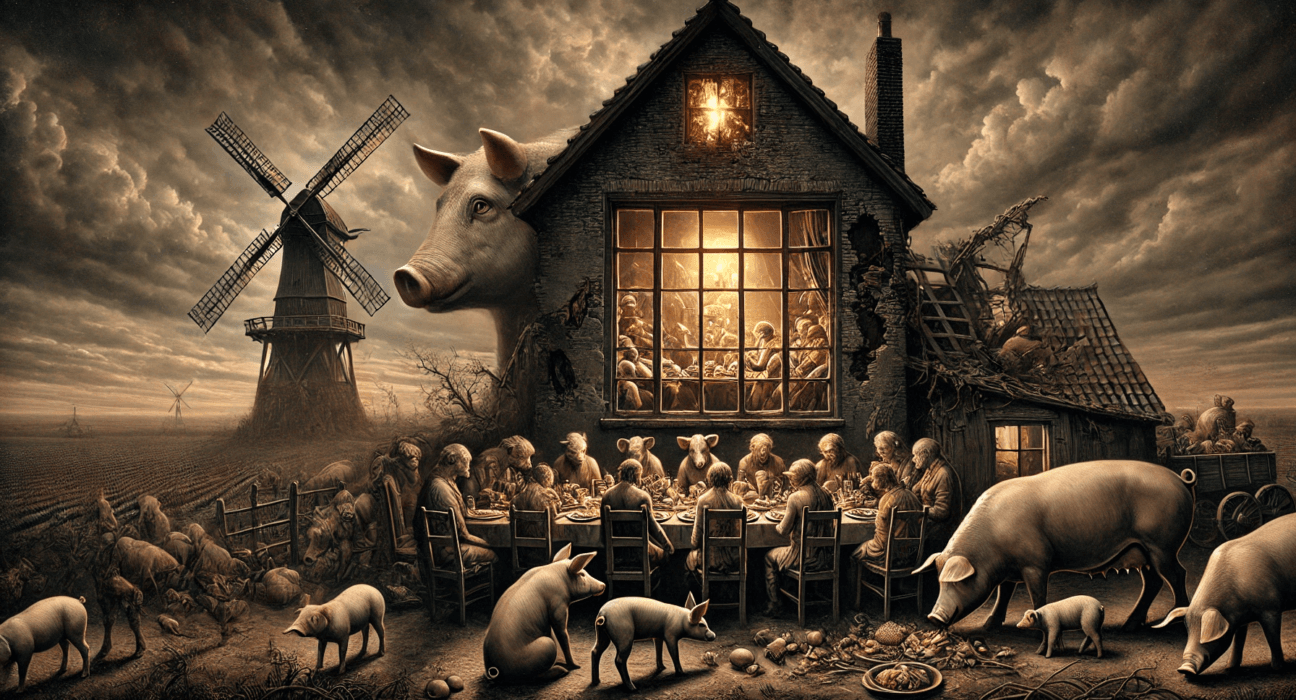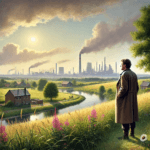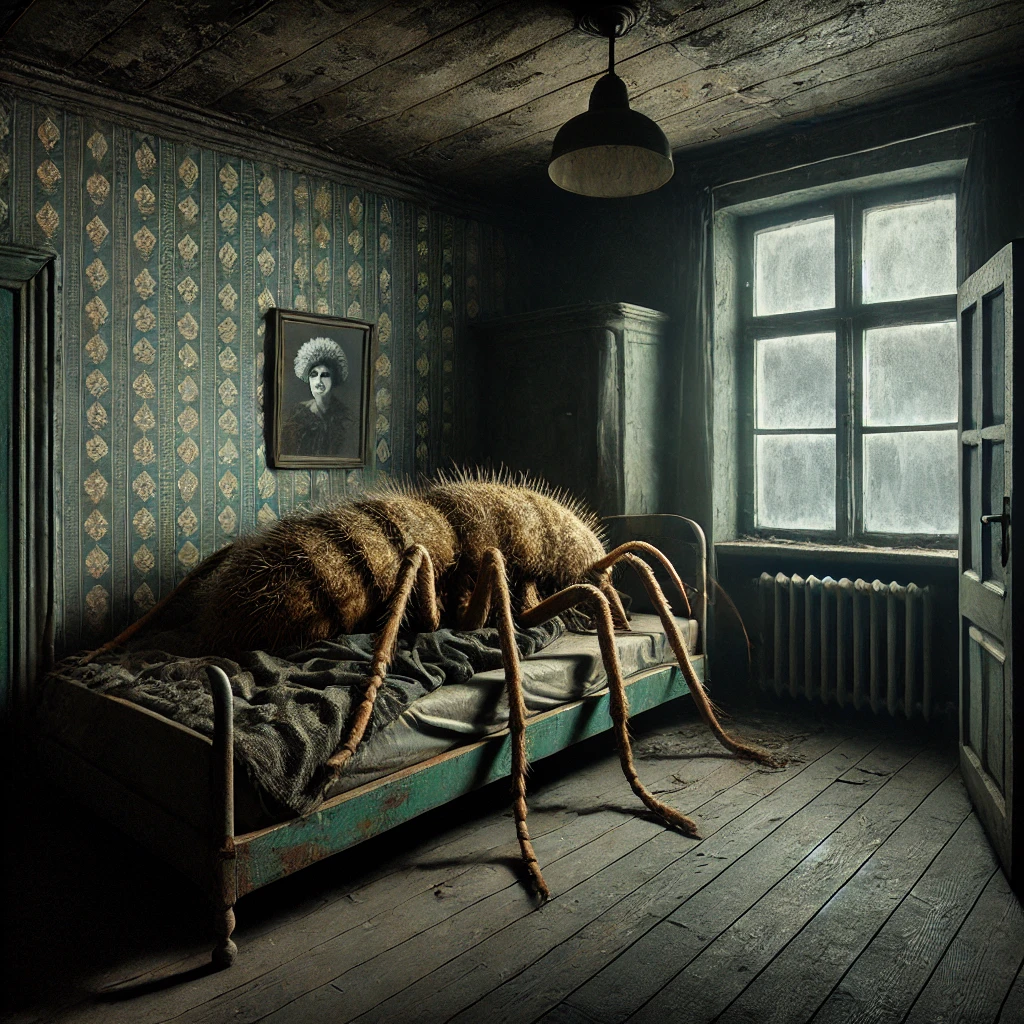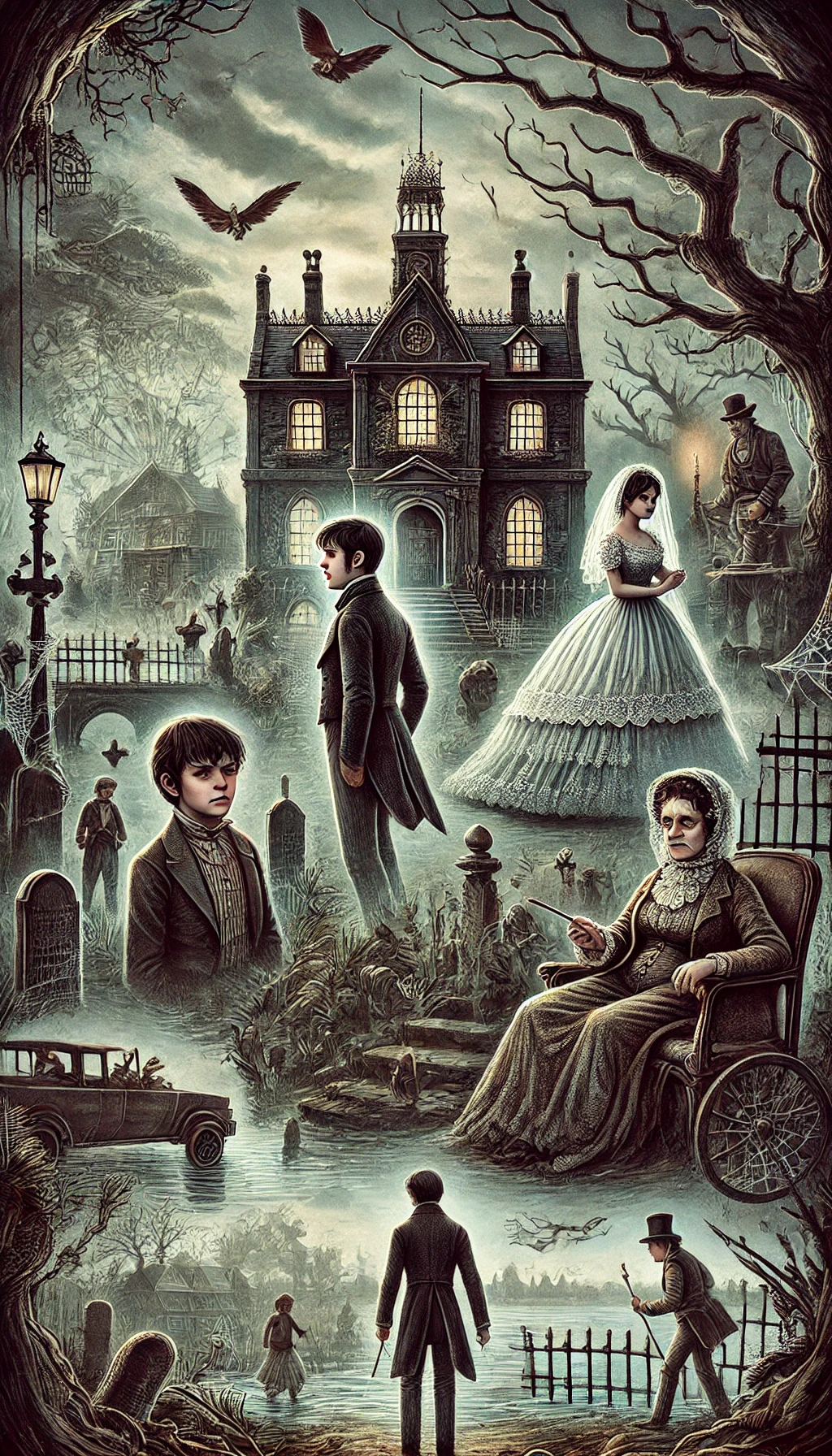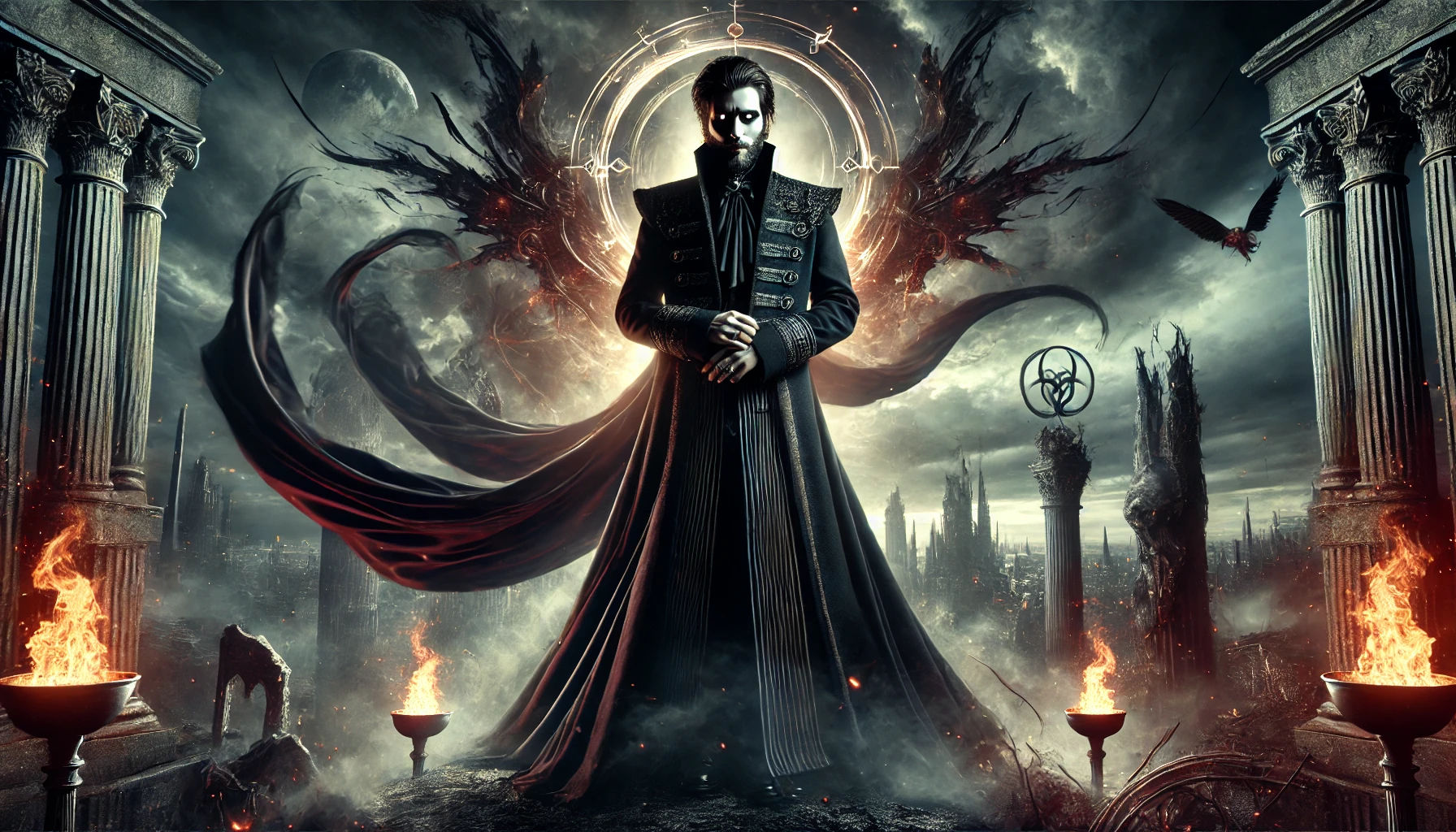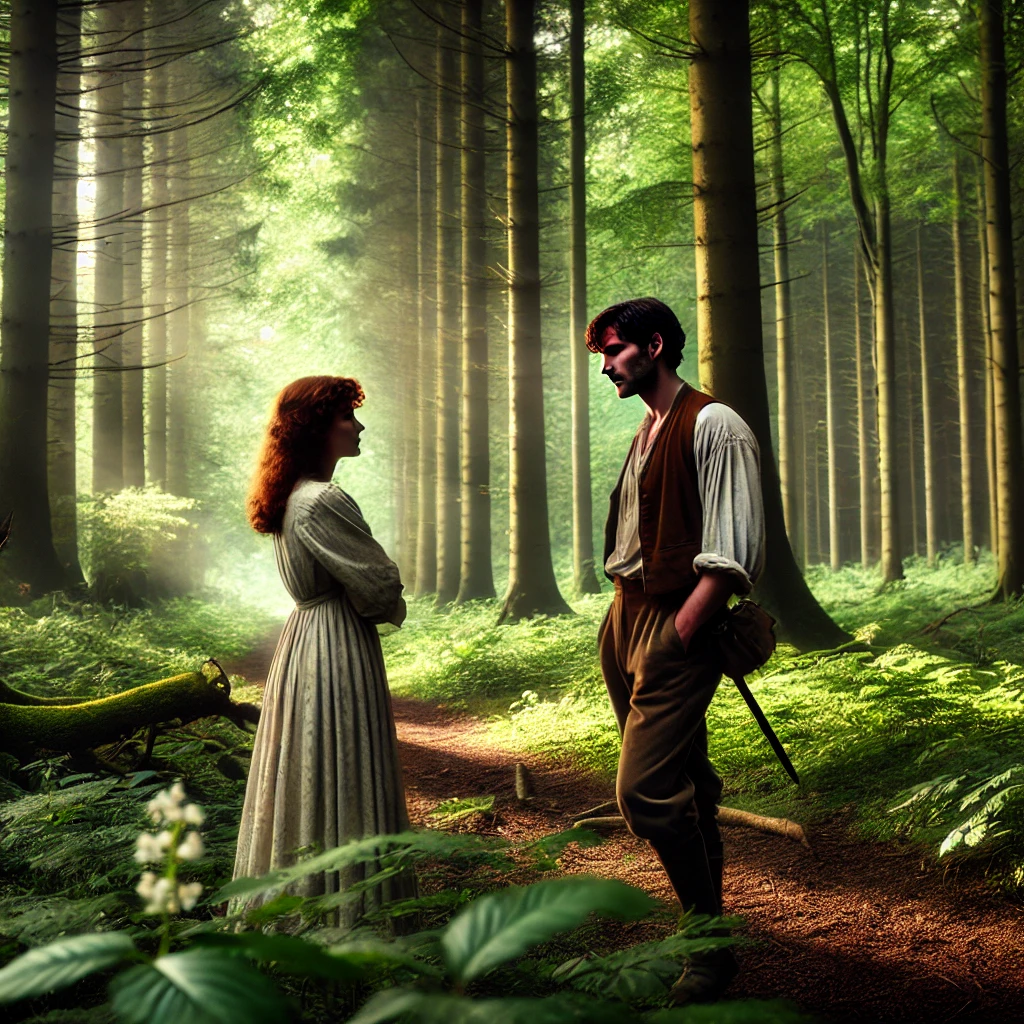Animal Farm by George Orwell, published in 1945, is a satirical allegory of the Russian Revolution and its aftermath, reflecting on the rise and corruption of totalitarian regimes. Set on a farm, the story explores how revolutionary ideals can be manipulated and betrayed by those in power. The novella’s sharp critique of power and propaganda remains as relevant today as it was at the time of its release.
Plot Summary
Under the shadow of the twilight, the farm lay still, yet within its heart, the animals stirred with a quiet, growing discontent. Mr. Jones, the owner of Manor Farm, stumbled drunkenly to bed each night, indifferent to the suffering of those who toiled under his rule. Among them was Old Major, a wise and revered boar, who called a secret gathering in the barn. There, he shared his dream of a world free from the tyranny of humans, where animals could live as equals, masters of their own destiny. His stirring words planted the seeds of rebellion in the minds of his listeners.
Shortly after, Old Major passed away, but his vision lived on. The pigs, recognized as the most intelligent of the animals, took charge of organizing his ideas into a philosophy they called Animalism. Chief among them were Napoleon, a cunning and imposing boar, and Snowball, his eloquent and idealistic counterpart. Together with Squealer, a persuasive pig with a silver tongue, they spread the doctrine across the farm. Though met with skepticism by some, the teachings gained traction, particularly among the hard-working Boxer, the maternal Clover, and the other loyal animals.
One fateful day, the long-anticipated moment arrived. Starved and mistreated, the animals rose in rebellion. Overwhelming Mr. Jones and his men, they seized control of the farm, renaming it Animal Farm. Joy surged through the creatures as they tore down the symbols of their oppression and vowed to uphold the Seven Commandments of Animalism, inscribed on the barn wall. Chief among these was the declaration that all animals were equal.
Initially, the farm thrived under its newfound freedom. The animals worked tirelessly, fueled by the belief that their labor was for the common good. The pigs assumed leadership roles, with Snowball devising grand schemes for progress, such as the construction of a windmill to ease their burdens. Napoleon, however, began to maneuver behind the scenes, quietly consolidating power.
The fragile unity shattered when Snowball was ousted. During a heated debate about the windmill, Napoleon unleashed a pack of ferocious dogs he had secretly raised, driving Snowball into exile. From that moment, Napoleon ruled as a dictator. Under his command, the animals’ lives grew harsher, though the pigs, shielded by layers of propaganda spun by Squealer, assured them that all was well. The windmill project, now Napoleon’s initiative, became a symbol of their collective toil and sacrifice.
As the seasons turned, the pigs grew increasingly indistinguishable from the humans they had overthrown. They appropriated privileges, indulged in luxuries, and manipulated the commandments to justify their actions. The windmill, once a beacon of hope, became a tool of exploitation. Boxer, the farm’s most dedicated laborer, embodied the spirit of perseverance, but even his unyielding strength could not protect him from the ruthless realities of the regime. When he collapsed from overwork, he was callously sold to the knacker, despite promises of care.
Time dulled the animals’ memories of the rebellion’s ideals. Squealer’s skillful manipulation of history, coupled with the animals’ lack of education, left them confused and powerless. The Seven Commandments dwindled to a single chilling maxim: “All animals are equal, but some animals are more equal than others.” The pigs walked upright, dressed in human clothes, and feasted alongside humans, mocking the dream of equality that once united the farm.
In the end, as the animals gazed through the farmhouse window, they saw Napoleon and the other pigs dining with human farmers. Laughter and toasts rang out, and deals were struck. The boundary between oppressor and oppressed blurred until it was impossible to tell who was who. Despair settled over the animals, who realized that the promise of freedom had been replaced by a tyranny all too familiar.
In this bitter twilight, the farm stood as a testament to the cycle of power and corruption, its ideals betrayed, and its inhabitants left to endure a new kind of servitude.
Main Characters
- Old Major: An aged boar whose vision of animal equality inspires the rebellion. Representing Karl Marx and Vladimir Lenin, he serves as a catalyst for revolutionary ideals, though he dies early in the narrative.
- Napoleon: A shrewd and manipulative pig who emerges as the farm’s autocratic leader. He symbolizes Joseph Stalin, using fear and propaganda to consolidate power while betraying the ideals of the rebellion.
- Snowball: An articulate and passionate pig, Snowball is Napoleon’s rival and represents Leon Trotsky. His vision for progress and education contrasts with Napoleon’s thirst for control, but he is exiled and scapegoated.
- Squealer: A small, persuasive pig who serves as Napoleon’s propagandist, symbolizing the media’s role in spreading misinformation and controlling public opinion.
- Boxer: A hardworking, loyal cart-horse whose personal motto, “I will work harder,” epitomizes the exploited working class. His eventual betrayal underscores the regime’s callousness.
- Clover: A maternal horse who represents the moral conscience of the animals. She questions the pigs’ corruption but feels powerless to resist.
- Benjamin: A cynical and skeptical donkey, Benjamin symbolizes the disillusioned intellectual who recognizes tyranny but chooses inaction.
- Mr. Jones: The drunken, neglectful owner of Manor Farm, he represents the overthrown monarchy or oppressive ruling class prior to the revolution.
- Moses: A tame raven who speaks of a utopian afterlife, “Sugarcandy Mountain,” representing organized religion as a tool of pacification.
Theme
- The Corruption of Ideals: The pigs’ gradual abandonment of the Seven Commandments of Animalism reflects how revolutionary goals are often corrupted by those in power. This theme critiques the ease with which noble aspirations can give way to tyranny.
- Power and Propaganda: Orwell illustrates the manipulation of truth and language to control the masses. Squealer’s justifications for Napoleon’s actions reveal how propaganda creates consent for authoritarian rule.
- Class Struggle: The novella examines the exploitation of the working class (Boxer and Clover) and the emergence of a new ruling class (the pigs), highlighting the cyclical nature of oppression.
- The Danger of Ignorance: The inability or unwillingness of the animals to question authority enables their exploitation. Orwell emphasizes the role of education in resisting tyranny.
- Leadership and Betrayal: Napoleon’s rise to power and eventual alliance with humans show how leaders can betray the very principles they claim to uphold.
- Equality vs. Inequality: The motto “All animals are equal, but some animals are more equal than others” encapsulates the inherent contradiction in the pigs’ regime.
Writing Style and Tone
Orwell’s writing style in Animal Farm is deceptively simple yet profoundly effective. The novella adopts the structure of a fable, using animals and their interactions to deliver a pointed critique of human society. This allegorical approach makes complex political themes accessible to a broad audience while retaining their satirical edge.
The tone oscillates between earnestness and irony, emphasizing both the sincerity of the animals’ initial revolutionary hopes and the bitter humor of their disillusionment. Orwell’s language is clear and unadorned, relying on straightforward narration and dialogue to underline the universality of his themes. His use of irony, especially in the pigs’ justifications for their actions, underscores the absurdity and tragedy of power’s corruption.
We hope this summary has sparked your interest and would appreciate you following Celsius 233 on social media:
There’s a treasure trove of other fascinating book summaries waiting for you. Check out our collection of stories that inspire, thrill, and provoke thought, just like this one by checking out the Book Shelf or the Library
Remember, while our summaries capture the essence, they can never replace the full experience of reading the book. If this summary intrigued you, consider diving into the complete story – buy the book and immerse yourself in the author’s original work.
If you want to request a book summary, click here.
When Saurabh is not working/watching football/reading books/traveling, you can reach him via Twitter/X, LinkedIn, or Threads
Restart reading!

